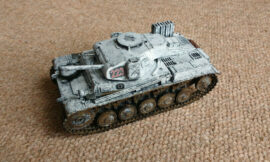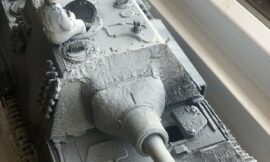The Panther Tank: Germany’s Iconic World War II Medium Tank
The Panzerkampfwagen V, commonly known as the Panther, was one of Nazi Germany’s most advanced and formidable tanks during World War II. Developed as a direct response to the Soviet T-34, the Panther combined firepower, mobility, and armor protection, making it one of the most effective and respected tanks of the war.
Development and Design
The development of the Panther began in 1941 after the German Army encountered the Soviet T-34 during Operation Barbarossa. The T-34’s superior armor, sloped armor design, and powerful 76.2mm gun outclassed the existing German tanks, prompting an urgent need for a new, more capable armored vehicle. The Panther was designed to address these shortcomings, blending the best elements of existing German and Soviet tank designs.
The first prototype, the VK 30.02 (MAN), was produced by Maschinenfabrik Augsburg-Nürnberg (MAN) and completed in 1942. The Panther featured several innovative design elements, including sloped armor that increased effective thickness and deflected incoming rounds, a powerful 75mm KwK 42 L/70 gun, and a torsion bar suspension system that provided excellent cross-country mobility.
Production Models and Variants
The initial production model, the Panther Ausf. D, was introduced in 1943. Early Panthers suffered from mechanical issues, including engine fires and transmission failures, which were gradually resolved in subsequent models. The Panther Ausf. A, introduced later in 1943, featured improvements such as a better-designed turret, reinforced final drive, and enhanced optics.
The most common and refined version was the Panther Ausf. G, which entered production in 1944. The Ausf. G included several design improvements, such as thicker and more angled frontal armor, simplified construction techniques to speed up production, and improved reliability.
There were also several specialized variants of the Panther, including command tanks (Panther Befehlswagen), recovery tanks (Bergepanther), and the Jagdpanther, a tank destroyer variant armed with an 88mm Pak 43 gun.
Combat Performance
The Panther saw its first major combat action at the Battle of Kursk in July 1943, where it played a crucial role despite initial mechanical problems. Its powerful 75mm gun could penetrate the armor of most Allied tanks at long ranges, and its sloped armor provided excellent protection against enemy fire.
On the Eastern Front, the Panther was highly effective against the Soviet T-34 and KV-1 tanks, earning a fearsome reputation among Soviet tank crews. The Panther’s combination of firepower, armor, and mobility made it a formidable opponent, capable of both offensive and defensive operations.
In Western Europe, the Panther was deployed in significant numbers during the Normandy Invasion, the Battle of the Bulge, and the defense of Germany. It proved to be more than a match for the American M4 Sherman and the British Cromwell, though it faced stiff competition from the heavily armed and armored British Firefly and American M26 Pershing.
Strengths and Weaknesses
The Panther’s strengths lay in its powerful main gun, well-sloped armor, and excellent mobility. Its 75mm KwK 42 L/70 gun had superior range and penetration compared to most Allied tanks, allowing Panther crews to engage enemies from a distance. The sloped armor design increased the tank’s effective protection without adding excessive weight, and the torsion bar suspension provided a smooth ride over rough terrain.
However, the Panther also had several notable weaknesses. Early models were plagued by mechanical reliability issues, and even later models required frequent maintenance. The tank’s complex design and high production costs limited the number of Panthers that could be fielded. Additionally, the Panther’s armor, while effective against frontal attacks, was thinner on the sides and rear, making it vulnerable to flanking maneuvers.
Legacy
Despite its shortcomings, the Panther was one of the most advanced tanks of World War II and influenced post-war tank design significantly. Its combination of firepower, armor, and mobility set a new standard for armored warfare, and many of its design principles were incorporated into post-war tanks, including the Soviet T-54/55 and the American M46 Patton.
The Panther remains a symbol of German engineering prowess and a key subject of study for military historians and tank enthusiasts. Its legacy endures as one of the most iconic and effective tanks of World War II, reflecting both the technological advancements and the challenges of wartime production and logistics.







